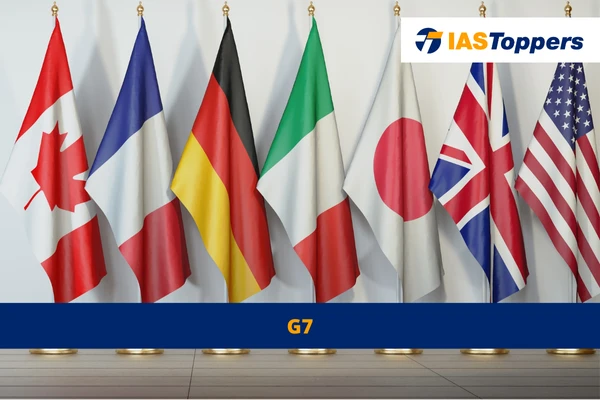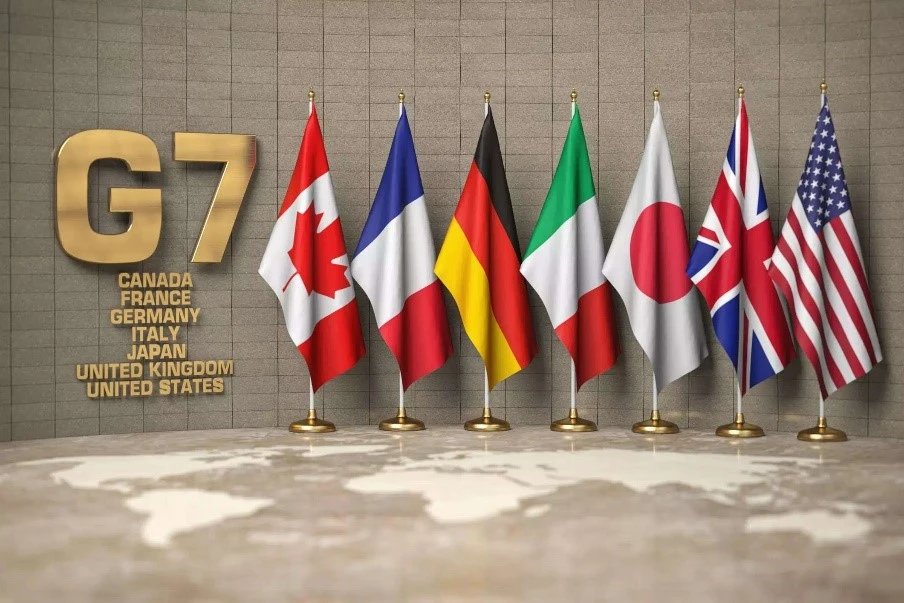G7 consists of major advanced economies the United States, Canada, France, Germany, Italy, Japan, and the United Kingdom (UK). In this article, you will learn definition, countries list, history, summits, initiatives, advantages, challenges and criticism, providing key insights for GS Paper-II Bilateral and International relations section of UPSC IAS Exam.
Table of Content
- What is G7?
- Background of G7 Summit
- Significance of the G7
- History of G7
- Advantages of G7
- Challenges faced by G7
- Criticism of G7
- Activities of G7
- Suggestions to improve the G7
- Conclusion
- Frequently Asked Questions
- Reference
What is G7?
- The G7 or the Group of 7 is a group of advanced democracies that gather annually to discuss various topics like global economic governance, international security, and energy policies.
- The group consists of major advanced economies the United States, Canada, France, Germany, Italy, Japan, and the United Kingdom (UK).
- It is built on shared values of pluralism, liberal democracy, and representative government.
Background of G7 Summit
- The annual G7 Summit brings together the heads of government or state of each member, along with the European Union’s Commission President and Council President.
- European Union’s Commission is the executive body of the EU.
- Prior to the gathering of national leaders, ministers and envoys, known as sherpas, from the G7 and the EU engage in discussions to formulate policy initiatives.
- In contrast to the United Nations or NATO, the G7 lacks a formal structure with a charter.
- The G7 operates without a treaty or permanent secretariat.
- Thus, it has no headquarters.
- There are no strict criteria for membership, but all participants are advanced economies and democracies.
- Group of 7 functions through a rotating presidency, with the hosting country setting the group’s priorities and organizing the summit.
- The president determines the agenda for the summit and organizes its logistical aspects.
- Other countries and international organizations are often invited as guests.
- Despite lacking a legal or institutional foundation, the G7 is widely recognized for its significant global influence.
Significance of the G7
- The combined GDP of G7 member states (excluding the EU) constitutes around 44% of the global economy in nominal terms.
- This has been declined from 70% three decades ago.
- G7 nations represent over half of global net wealth and 10% of the world’s population.
- Some of its members hold significant influence in global affairs and maintain strong political, economic, diplomatic, and military relations.
- It played a crucial role in initiating major global initiatives, such as combating the HIV/AIDS pandemic, providing financial aid to developing nations, and addressing climate change through the Paris Agreement in 2015.
History of G7:
- On March 1973, the U.S. Secretary of the Treasury had organized an ad hoc gathering of finance ministers from West Germany, France, and the United Kingdom to discuss the 1973 oil crisis.
- The meeting took place in the library on the ground floor of the White House, thus the initial group of four came to known as the “Library Group.”
- In late 1973, during the Spring Meetings of the International Monetary Fund and the World Bank, the inclusion of Japan was proposed and accepted by all the members.
- The informal gathering of senior financial officials from the U.S., U.K., West Germany, Japan, and France came to be known as the “Group of Five.”
- In 1975, the Group of Six was established by the United States, France, Italy, Japan, the UK, and West Germany to address important economic issues, such as inflation and a recession triggered by the Organization of the Petroleum Exporting Countries (OPEC) oil embargo.
- In 1976, the Canada joined the group, and Cold War dynamics had influenced their discussions.
- The summit was also known as the “Rambouillet II”.
- In 1977, the United Kingdom, as the host of that year’s summit had extended an invitation to the European Economic Community to join all G7 summits.
- Since 1981, the European Union (EU) has been a full participant of the G7 by serving as its “non enumerated” member.
- Thus, G7 wasfounded for the first time.
- Russia was a formal member from 1997 to 2014 as part of the Group of Eight or G8.
- Russia was suspended after annexing Ukraine’s Crimea region.
- During the 1980s, the G7 expanded its focus beyond macroeconomic matters and started addressing international security and conflicts.
- Prior to the 1985 Plaza Accord, the meetings involving the finance ministers of the seven governments were kept confidential.
- The G7 has evolved into a formal platform for discussing and coordinating solutions to critical global issues, including trade, security, economics, and climate change.
- 2020 summit was cancelled due to the worldwide coronavirus pandemic.
Advantages of G7
- The forum’s small and similar membership facilitates joint decision-making.
- It acts as a manageable steering group for the Western countries, embodying shared values and a rules-based approach to global order.
- G7 provides a useful platform for renegotiation, allowing members to address disagreements before presenting proposals to the G20 or other forums.
Challenges faced by G7:
- The G7 is challenged by ongoing tensions with Russia and China
- European G7 leaders are facing regional challenges, such as navigating Brexit and managing growing nationalism.
- The rise of China as a military and economic power, nuclear proliferation, and the advancements in artificial intelligence presents challenges.
- The Belt and Road Initiative of China has raised concerns about China’s increasing influence over developing nations.
- There are constant nuclear threats from Russia and North Korea.
- This has reignited concerns about nuclear weapons.
Criticism of G7:
- It faces opposition from anti-globalization groups, who often protest during its summits.
- There are internal disagreements amongst its members regarding trade and climate policies.
- It has outdated and limited membership, lack of global representation, and perceived ineffectiveness.
- It excludes influential emerging nations this diminishes the relevance of group.
- The power and influence of the Group of Twenty (G20) has surpassed that of the G7.
- G20 member countries represent approximately 78% of global Gross Domestic Product (GDP) and comprise three-fifths of the world’s population.
- The G20 was most effective during the global financial crisis of 2007-08.
Activities of G7:
- In the 1990s, it launched a debt-relief program for the 42 heavily indebted poor countries to help build the Shelter Structure over the damaged reactor at Chernobyl, Ukraine.
- They have established the Financial Stability Forum in 1990s to help managing the international monetary system.
- The G7 had achieved a significant agreement on restructuring global corporate taxation prior to its 2021 summit held at United Kingdom.
- At the 2022 summit, the Build Back Better World initiative was launched to establish the Partnership for Global Infrastructure and Investment as an alternative to the Belt and Road Initiative.
- The G7 has committed $600 billion investments for this new strategy.
- The group has collectively imposed sanctions on Russia in response to its actions in Ukraine.
- The group has also launched a global infrastructure initiative to counter China’s Belt and Road Initiative.
- The G7 members has collectively pledged over $100 billion in financial aid to Ukraine, with all members except Japan providing weapons support.
- G7 ministers committed to a new collective agreement on climate protection and energy security where the countries agreed to increase offshore wind and solar capacity by 2030.
- Though specific deadlines for phasing out coal or limiting investments in natural gas were not set.
Suggestions to improve the G7:
- The G7 shall abandon the objective of GDP growth and focus on achieving real economic objectives that matters most.
- A binding code of conduct upholding democratic governance of economies will ensure more ethical practices worldwide.
- Expand the G7 to include Australia, India, and South Korea to form a “D10” group of democracies.
- A new group comprising the United States, China, the European Union, India, Japan, and Russia shall be formed which is similar to the 19th century Concert of Europe.
- This system must have permanent representatives supported by a secretariat to address the temporary nature of G7 and G20 summits.
- The focus shall be on practical cooperation rather than ideological alignment, avoiding negotiations over insignificant communiqués.
- A windfall tax on technology byG7 countries can help develop Citizen Wealth Funds at the country level to fund universal basic income, public services and infrastructure development.
Conclusion
The G7 remains valuable as its member countries are facing the similar issues. The G7 (Group of Seven) holds a significant position in shaping global economic policies and fostering international cooperation. As the world continues to evolve, the G7’s commitment to inclusive growth, cooperation, and shared values will shape the future of international relations and foster a more prosperous and sustainable world. The president of G7 in 2023 is Japan.
Ref: Source-1
FAQs (Frequently Asked Questions)
How many countries in G7?
There are 7 nations in G7.
What is G7 summit?
The G7 or the Group of 7 is an annual summit of group of advanced democracies that gather annually to discuss various topics like global economic governance, international security, and energy policies.
Is India a member of G7?
India is not a member of G7, yet it has been invited in many of its summits as a guest country.
When was G7 formed?
The G7 was originally G8 that was originated in 1973 and was set up in 1975.
Which are the G7 countries?
The G-7 countries includes Canada, France, Germany, Italy, Japan, U.K. and U.S.



